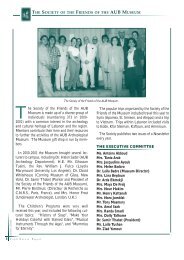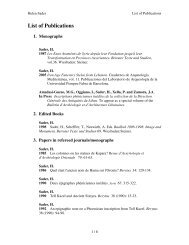The IX t h Makassed Medical Congress - American University of Beirut
The IX t h Makassed Medical Congress - American University of Beirut
The IX t h Makassed Medical Congress - American University of Beirut
Create successful ePaper yourself
Turn your PDF publications into a flip-book with our unique Google optimized e-Paper software.
T h e I X t h M a k a s e d M e d i c a l C o n g r e s s<br />
Transcatheter Aortic Valve Implantation Kapadia and Tuzcu 469<br />
Figure 1. Different approaches for implanting a transcatheter aortic valve. A, Transfemoral approach. B, Transapical approach. C, Transseptal approach.<br />
Implantation approaches<br />
• <strong>The</strong> prosthetic valves can be delivered in retrograde or antegrade fashion<br />
(Fig. 1). Currently, the CoreValve can be deployed only retrogradely,<br />
whereas the Sapien valve can be deployed antegradely or retrogradely.<br />
<strong>The</strong> retrograde delivery is commonly performed from the femoral artery,<br />
but subclavian access has been used in some patients with signifi cant<br />
ili<strong>of</strong>emoral disease receiving the CoreValve device. In the initial experience<br />
with the fi rst-generation Cribier-Edwards valve (an equine valve;<br />
Edwards Lifesciences), transseptal access allowing an antegrade approach<br />
was used. An antegrade approach from the apex <strong>of</strong> the heart<br />
(transapical) has been used in some patients with severe ili<strong>of</strong>emoral<br />
disease receiving the Edwards Sapien valve.<br />
• <strong>The</strong> transfemoral approach (Fig. 1A) is the simplest and quickest way to<br />
access the aortic valve. Access is obtained by percutaneous puncture or by<br />
surgical cutdown <strong>of</strong> the femoral artery. Perclose devices (Perclose, Menlo<br />
Park, CA) typically are used to close the arteriotomy if the percutaneous<br />
approach is used. <strong>The</strong> aortic valve is then crossed in the usual manner,<br />
commonly using an AL1 catheter and a straight wire. A stiff wire is placed<br />
in the left ventricle with a big loop. A temporary pacing wire is placed in<br />
the right ventricle for rapid pacing. Rapid pacing is critical for the balloon-expandible<br />
valve to avoid unintentional motion <strong>of</strong> the valve during<br />
deployment. Initially, the aortic valve is dilated using a 20- to 23-mm<br />
balloon with rapid pacing. Following this procedure, the prosthetic valve<br />
is advanced into position and the native aortic valve is crossed. Positioning<br />
<strong>of</strong> the valve at the correct height is a crucial step during transcatheter<br />
valve replacement because currently available valves are not repositionable.<br />
Transesophageal echocardiographic and fl uoroscopic guidance is<br />
necessary for accurate positioning. <strong>The</strong> valve is deployed under rapid pacing<br />
once the satisfactory position is achieved for the Edward Sapien valve.<br />
<strong>The</strong> CoreValve is deployed without pacing by unsheathing the valve.<br />
Proper valve deployment is confi rmed by online imaging.<br />
• With the transapical approach (Fig. 1B), access is obtained by mini-thoracotomy.<br />
<strong>The</strong> apex <strong>of</strong> the heart is punctured using a needle after two layers<br />
<strong>of</strong> pursestring sutures are placed around the intended site. <strong>The</strong> aortic valve<br />
84
















